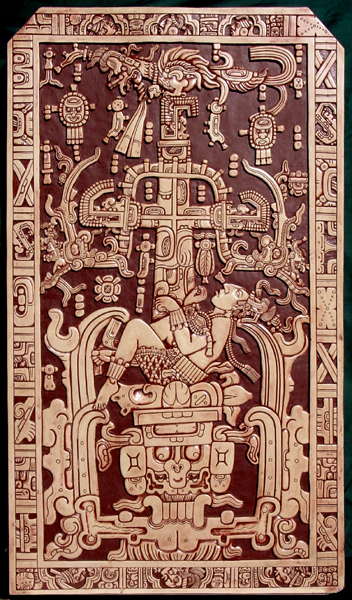MEXICO CITY, MEXICO – Mayan king Pakal’s soul was destined to go down, not up, archaeologists say.
In 1968, Erich von Daniken wrote his famous book Chariots of the Gods. In it, he speculated on the Mayan ruin site of Palanque. Specifically, he focused n the Temple of Inscriptions, where the ancient Mayan ruler, Pakal, was buried.
Pakal was entombed in a stone sarcophagus. On this sarcophagus is engraved a picture of the dead king. Erich von Daniken believed the picture depicted Pakal seated at the controls of a spaceship-like contraption, surrounded by flames. Perhaps the king was believed to have ascended to the afterlife through the sky. After all, the pyramids of ancient Egypt were believed to be stepping stones, paths to the sun for the spirit of the god-king to climb to paradise everlasting.
However, this theory about what the coffin engraving is actually depicting stems from a basic misunderstanding about Mayan concepts about where the soul went when it died.
In 2012, researchers were examining the Temple of Inscriptions using geo-radar when they detected a troubling anomaly beneath the pyramid’s steps. It seemed the pyramid was built on top of a fault or a hole. They were afraid it that such a fault might cause the temple to eventually collapse, so they dug into the ground to see what was there.
What they found wasn’t what they expected to find.
Beneath the stone steps of the temple, they found three layers of stone that had been carefully fit together to cover the top of a tunnel. The covering matches the floor of Pakal’s tomb, according to Arnoldo Gonzalez, an archaeologist working on Pakal’s tomb in the Temple of Inscriptions.
A similar tunnel was found at Teotihuacan, near Mexico City was found. In both tunnels, there was a water current. The Maya believed strongly in the spiritual significance of water and water currents. Water was where life began and where it ended.
Archaeologists began to wonder whether or not the tunnel was designed to carry the dead king’s soul to the afterlife through the conduit of a water current. Though, no shaft has been found that connects Pakal’s tomb with the water tunnel, one strong link between the two has been identified.
According to Gonzalez, a pair of stone ear plugs were found interred as grave goods in Pakal’s burial chamber. When archaeologists examined them, they found carvings on the stone. When read, these translated: “a god will guide the dead toward the underworld by submerging (them) into the water so they will be received there.”

PHOTO: sacredsites.com
It’s pretty compelling evidence that Pakal’s spirit was believed to travel downward into the ground, not upward into the stars.
As of yet, Archaeologists have found no physical link between the stone tunnel and the burial chamber, but Gonzalez doesn’t want to rule one out just yet. The tunnel only measures two feet wide and two feet tall. It’s too small for anyone to crawl into and check!
Researchers at the Temple of Inscriptions intend to further explore the tunnel and see if a connecting shaft can be found. They’ve already sent a robot down into it to take some pictures and probe the horizontal section of the shaft.
There’s one more nail in the proverbial coffin of Erich von Danikan’s spaceship theory in Chariots of the Gods. The “flames” coming out of the “spaceship” probably aren’t flames at all. The Maya believed in a World Tree, or a Tree of Life, whose roots were believed to extend deep into the earth, all the way to the underworld. The flames are probably roots.
The depiction is not of Pakal riding an alien chariot towards the sun, but rather of him riding a water current down the trunk and roots of a tree to where the Maya really believed the underworld was. From the roots of the tree, from the water, a god would receive him and guide him to eternity beneath the Earth.


